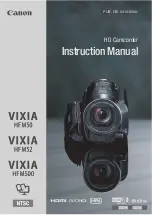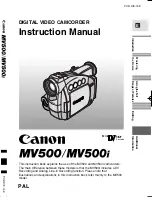
15
Basic Functions
Camera ID
The ID can be set up to 65,536 (0000 to FFFF). As this
will be memorized in the nonvolatile memory inside,
data will be saved regardless of whether it has been
backed up.
Effect
It consists of the following functions.
•
Neg. Art:
Negative/Positive Reversal
•
Black White:
Monochrome Image
Others
E-FLIP
This function turns the video output from the camera
upside down.
Mirror Image
This function reverses the video output from the
camera horizontally.
Freeze
This function captures an image in the field memory of
the camera so that this image can be output
continuously.
Because communication inside the camera is based on V
cycle, the captured image is always the one 3V to 4Vs after
the sending of a Command. Thus, you can not specify a time
period after sending EVEN, ODD or a Command.
Memory (Position preset)
Using the position preset function, 6 sets of camera
shooting conditions can be stored and recalled.
This function allows you to achieve the desired status
instantly, even without adjusting the following items
each time.
•
Zoom Position
•
Digital Zoom On/Off
•
Focus Auto/Manual
•
Focus Position
•
AE Mode
•
Shutter control parameters
•
Bright Control
•
Iris control parameters
•
Gain control parameters
•
Exposure Compensation On/Off
•
Exposure Level
•
Backlight Compensation On/Off
•
Slow Shutter Auto/Manual
•
Slow AE Response speed
•
White Balance Mode
•
R/B Gain
•
Aperture
•
ICR Shoot On/Off
•
WD On/Off
Custom Preset
As with the position preset function, the camera
shooting conditions can be stored and recalled. The
settings are recalled when the power is turned on.
For setting items, see the “Initial Settings, Custom
Preset and Backup” section on page 28.
User Memory Area
A user area of 16 bytes allows you to write data, such
as an ID for each customer, data for each system, and
so on, freely.
Note
Rewriting of memory is not unlimited. Be careful to avoid using
the memory area for such as unnecessary tasks as rewriting the
contents of the memory for every operation.
Register Setting
The camera’s default settings can be changed by the
register setting command.
Register Setting Command:
8x 01 04 24 mm 0p 0q FF
mm: Register No. (=00 to 7F)
pq: Register Value (=00 to FF)
Register Inquiry Command:
8x 09 04 24 mm FF
mm: Register No.
y0 50 0p 0p FF
pp: Register Value
(returned from the camera)
Example: To set communication speed to 38400 bps
8x 01 04 24 00 00 02 FF
After sending this command, turn power off and
back on (power reset) to resume communication
control at 38400 bps.
Example: Sending to confirm settings
8x 09 04 24 00 FF
y0 50 00 03 FF is returned from the camera
The register setting items and No. are as follows.
Baud Rate: 00
Communication speed can be changed.
OSD Language: 60
OSD Language can be changed.
CCD Scanning Mode: 72
CCD scanning mode can be changed.
Digital Output Mode: 73
The FCB camera supports various output modes.
This register “73” allows changing the output
mode.
For details, see “Register Setting” on page 59.
Zoom Limit: 50 (Wide end), 51 (Tele end)
The Wide and Tele zoom limits can be set.
E-Zoom Max: 52
The maximum digital zoom limit can be specified
(default is
×
12).
StableZoom: 53
The StableZoom command can be enabled and
disabled with this command.
















































